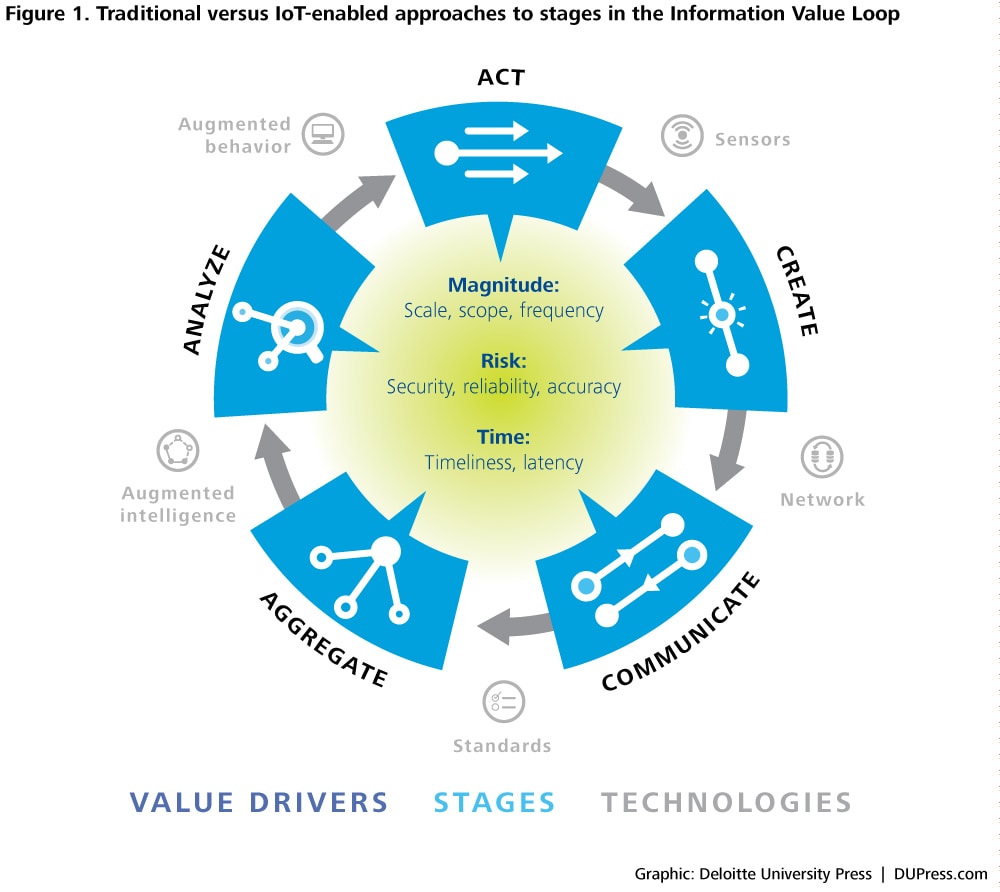No appointment necessary: How the IoT and patient-generated data can unlock health care value has been saved

No appointment necessary: How the IoT and patient-generated data can unlock health care value The Internet of Things in health care
28 August 2015
Doctors have gathered data on patients’ ailments and histories since Hippocrates, and current, accurate information is critical to effective health care. By making measurements and analysis automatic, IoT applications promise to help improve and personalize care—and create new value for industry players.
Introduction
In striving to improve outcomes and reduce costs, health care providers have long struggled with several nagging problems—most notably, their interactions with their patients are sporadic, giving them little insight into the daily decisions and activities that have a huge impact on patient health. Providers could be much more effective in supporting their patients’ health if it was easy, or even automatic, for information and feedback to flow between patients, providers, and caregivers. Fortunately, new technology is making that increasingly possible.
Over the last two decades, the data-driven suite of technologies dubbed the Internet of Things (IoT) has transformed some industries and disrupted others,1 with increasingly sophisticated analytical capabilities fundamentally altering the ways businesses serve customers.2 Health care providers have lagged behind other industries in adopting IoT innovations and using available customer data to inform decision making, but the shift is taking place.3
Receive IoT insights
Subscribe
Explore the
Internet of Things collection
Where data about consumers have been critical to the transformation in retail, in health care the key is patient-generated data (PGD), defined as “health-related data created, recorded, gathered, or inferred by or from patients or their designees to help address a health concern.”4 PGD includes patient reported outcomes, medical-device data, and wearables data, in addition to the application of consumer-generated data in a health care setting. Of course, patients make the bulk of their health care decisions outside a clinical setting, and most of those decisions are lifestyle choices rather than doctor-advised medical actions. Cumulatively, these decisions have a major effect on an individual’s health, and employers, insurers, and health care providers have much at stake in changing patient behavior. After all, it has been estimated that in the United States, everyday behaviors lead to conditions that cause 40 percent of premature deaths.5 Given that digitally collected patient-generated data are more reliable than the self-reported alternative, IoT applications can be critical to improving and personalizing health care, even encouraging behavior changes before they result in illness.6
Not only can IoT technologies help organizations improve health management, the personalization of care and improved patient engagement through IoT technology will make health organizations more competitive and attract more customers in an ever more consumer-driven market.7
Health care’s transition to embracing IoT technologies, while not the first of its kind among consumer-facing industries, faces unique challenges. The IoT is about data and in its most mature form will be an ecosystem of a diverse set of organizations, companies, and consumers, all creating and using different types of data—some significantly more sensitive than others. Complexities arise when non-health organizations are players in an ecosystem that creates and transmits sensitive health information. Thus, the benefits of the IoT and PGD will rely upon an effective answer to this and other complexities, including market adolescence, clinician adoption, big-data challenges, and regulatory modernization.
PGD and the IoT Value Loop
Many industries are experiencing meteoric growth in available information with the potential to inform decision making, and health care is no exception. The new breed of digital PGD is increasingly generated by IoT technologies and associated business processes that offer the ability to track activities, identify choices, evaluate outcomes, and act in circumstances that were previously effectively beyond reach and influence.
The technologies that enable the IoT promise to turn almost any object into a source of information about that object. This creates both a new way to differentiate products and services and a new source of value that can be managed in its own right. However, PGD itself is hardly new—doctors have gathered data on patients’ ailments and histories since Hippocrates. To understand what IoT technologies have changed and what remains the same requires a model of information flow through the patient-care team interaction. Indeed, realizing PGD’s full potential requires a framework that captures the series and sequences of activities by which organizations create value from IoT-generated information: the Information Value Loop.
Within this framework, information passes through stages enabled by specific technologies to create value. An act is monitored by a sensor, which creates information. That information passes through a network so that it can be communicated, and standards—whether technical, legal, regulatory, or social—allow that information to aggregate across time and space. Computational methods of analytical support, which we call augmented intelligence, are collectively used to analyze information. The loop is completed via augmented-behavior technologies that either enable automated autonomous action or shape human decisions in a manner leading to improved action.
In health care delivery, PGD passes through the same value loop as it informs behavioral and treatment changes to improve health, extend access, and reduce costs (see table 1).
As information flows around the loop and creates value, bottlenecks may occur at different points that inhibit value creation.8 By targeting these bottlenecks, organizations can not only maximize IoT-generated value but also gain a strategic advantage over competitors in controlling a key portion of the value loop.
Several bottlenecks may inhibit the realization of the benefits from PGD use in health care delivery. By examining the technology’s different uses in care delivery and the cross-cutting bottlenecks that each of those uses encounters in the value loop, strategies emerge that will allow organizations to navigate the nascent world of PGD, gain a strategic advantage, and maximize the benefits of increased data-driven decision making.
Table 1. The Value Loop and PGD
| Stage | PGD examples |
Create |
|
Communicate |
|
Aggregate |
|
Analyze |
|
Act |
|
Applications of PGD to improve health care
“Within five years, the majority of clinically relevant data . . . will be collected outside of clinical settings.”9
Health care organizations typically adopt technologies slowly, requiring a greater degree of evidence to demonstrate significant impact and efficiency. As PGD’s use increases, three areas in particular offer a growing evidence base for value in improving health outcomes, reducing cost, and expanding access to care:
- Short-term care planning
- Chronic-disease management and home care
- Population-based evidence creation
PGD—whether generated via mobile technologies, medical devices, or patients’ personal computers—carries tremendous potential to lower costs and improve outcomes by helping patients track key health information while assisting providers in more effectively tailoring treatments for the individual or public overall. These technologies save health systems money by lowering readmission rates, reducing appointment no-shows, and promoting adherence to care plans.
In the coming decades, demographic changes will increase opportunities to apply IoT technology to support wellness and health care for particular segments of the population. An aging Baby Boomer generation will drive market growth for technologies, such as glucose monitors and motion sensors that allow them to manage their chronic conditions and age within their own homes. As health care systems begin to shift toward bundling payments and developing accountable-care organizations, providers are increasingly rewarded or compensated based on health outcomes. PGD not only provides ways to streamline care delivery and improve outcomes—it may help to define value in the context of care.
1) Short-term care planning
The transition from an acute illness or surgical event back to normal health represents many challenges for patients, and the quality of short-term care is a major determinant in recovery. Traditionally, patients’ treatment and recovery have been informed by printed or handwritten doctor’s notes and discharge forms. PGD presents a significant opportunity to customize care and support patients throughout their treatment and post-operative care plans through greater education, reminders, and monitoring/early detection. Care-plan-specific mobile apps monitor patient actions, such as following their physical-therapy or wound-care plans. This information passes through a data network that providers, patients, and caregivers can analyze, aggregate, and communicate to facilitate augmented intelligence about their care plans and augmented behavior, such as adhering to a medication regimen or understanding post-procedure instructions.
Market for using PGD to deter hospital readmissions
Preventable readmissions cost the health care system approximately $17.5 billion annually.10
Researchers have shown that increased support substantially promotes care-plan adherence and improves quality outcomes while lowering costs through reduced hospital readmissions and office visits. 11, 12 In addition to the costs directly associated with readmission, a portion of the Affordable Care Act specifically penalizes hospitals for high readmission rates within 30 days of discharge, providing additional incentive for providers to embrace new means of supporting patients after direct care ends. 13,14
Table 2. Short-term care planning
Type of data |
Current state |
Examples of IoT |
Benefits |
Patient care plan
|
|
|
When collected and monitored across an entire patient population, PGD can also support identification of high-risk individuals who are most prone to complications and potential readmission. This enables care teams to make targeted interventions with particularly susceptible patients, thereby more effectively allocating clinical resources for the greatest effect on improving quality and reducing cost.
To realize such value of PGD in short-term care planning, health care providers will not only need to embrace new digital technologies to further engage patients after and between episodes of care—they will need to adopt business and staffing models that support such continuous patient engagement and care management.
2) Chronic-disease management and home care
Chronic-disease management and home care present high-impact areas in which increased use of PGD can provide immediate results. However, the chronically ill, frail, and elderly currently rely at best on discrete and intermittent interactions with their doctor over long periods of time to manage their conditions and, at worst, must live in long-term care facilities instead of in their own homes in order to manage their health conditions.
With IoT, patients can use sensors such as fall detection devices and remote glucometers to create information ranging from acute injury to diabetic coma, which is passed through provider data networks and communicated with set standards and aggregated, leading to augmented intelligence about patients and augmented patient behavior, such as healthy dietary habits and medication compliance.
Additionally, as in post-operative care planning, the organization-wide collection and analysis of PGD for chronic-disease management and home care enable providers to monitor patient populations and identify and intervene with individuals most at risk for deteriorating health.
Chronic-disease management
Chronic-disease management will likely be a key area for IoT applications to help deliver cost savings and health-outcome gains. With chronic-disease management driving 86 percent of direct health expenditure, providers have an untapped resource to realize cost and quality improvements through the collection and use of PGD.18
Table 3. Chronic-disease management use cases
Type of data |
Current state |
Examples of IoT |
Benefits |
Longitudinal clinical data
|
|
|
|
Behavioral and wellness data
|
|
|
Opportunities for PGD in chronic-disease management
- As of 2012, 133 million Americans (approximately one in two adults) have a chronic disease
- Chronic diseases account for approximately 70 percent of deaths in the United States25
- Chronic disease accounts for 86 percent of America’s direct health expenditure26
- Remote patient monitoring is expected to save up to $36 billion globally over the next five years27
Clinical data applications have already shown potential to improve health outcomes through early detection of dangerous events, lower medical costs by reducing the need for emergency care, and increase health-system productivity by reducing the frequency and length of hospital visits.28, 29, 30 For behavioral and wellness interventions, research is still needed to clarify the return on investment.31
Home care
As the population ages, providers will spend a greater proportion of medical expenditure on the elderly.32 With nursing-home and assisted-living costs already high and trending upward,33 health organizations have every reason to encourage more elderly individuals to live independently in their own homes by helping to mitigate risks that accompany home living.
Home monitoring of an aging population via apps, sensors, and other devices helps people to live at home safely by proactively identifying those who can no longer live safely at home, and by providing a range of support services for those that do. For example, IoT can provide early detection and rapid response to medical emergencies, support patients’ adherence to often-complex medication regimens, and offer the elderly and their caregivers greater confidence. By improving patient-facing technologies and analytics, providers can identify when an individual deviates from his or her normal routine, when a caregiver or family member should check in, or when emergency response is appropriate.
Fall detection devices using PGD
- Wearable devices: Electronic sensor-based devices worn by the individual
- Context-aware devices: Sensors deployed in the environment to detect accidents34
In particular, home monitoring—far more broadly capable than the traditional Life Alert-style audio system35—has the potential to greatly reduce the incidence of death and hospitalization incurred by falls.36 According to the Centers for Disease Control, falls are the leading cause of both fatal and nonfatal injuries in adults 65 and older.37 One out of three older adults falls each year,38 though less than half of them mention this to their providers.39 In 2013, direct medical costs due to falls reached $34 billion.40 Furthermore, people who fall are more likely to eventually be admitted to long-term care facilities,41 with yearly costs averaging over $80,000.42 IoT-based home monitoring devices have the ability to cut costs and improve outcomes by preventing falls by predicting the likelihood of a fall and observing movements and pressure distribution.43
Table 4. Home care use case
Type of data |
Current state |
Examples of IoT |
Benefits |
Home activity data
|
|
|
Though comparatively few of today’s seniors are using communication-linked technology to monitor themselves, caregivers and family members often utilize this technology. In their role as caregivers to aging parents, Baby Boomers have also embraced new technology and will likely increase their use for in-home monitoring as IoT-based devices become commonplace.47 As that generation ages, health systems can embrace mobile technology and the potential for cost savings due to better in-home monitoring of the elderly and the disabled.
In order to achieve such benefits of PGD in chronic-disease management and home care, organizations will need to take a more active role in supporting patients’ ongoing health, driven not only by a greater body of evidence of how PGD can be used to inform care management decisions, but also a commitment on the part of individual clinicians to putting this data to use and fostering ongoing relationships with patients for their health.
3) Population-based evidence
Not only can providers use PGD at the point of clinical care to promote health and wellness in individuals—they can analyze PGD at the population level to better understand how certain health determinants affect patient populations. Currently, studies with PGD conducted at the population level are largely limited to health underwriting and risk analysis—not health management and disease prevention.48
Greater embrace of IoT applications can enable the discovery of not only what patients are most at risk in the long term but also how to personalize care as these patients pursue their wellness goals, and what factors not typically measured in a clinical encounter most impact patients’ health. This occurs via the creation of sensor, mobile, online, and other data at the create stage, which organizations eventually aggregate and analyze to augment behavior in the form of more informed and nuanced clinical guidelines and policy.
Table 5. Population-based evidence use cases
| Type of data | Current state | Examples of IoT opportunities | Benefits |
Clinical and nonclinical data |
|
|
While these capabilities are still in their infancy, early examples have shown promise in their ability to inform treatment guidelines. For example, the Health eHeart study at the University of California San Francisco hopes to discover new ways to predict heart disease and understand its unique causes in patient populations by aggregating and analyzing patients’ clinical and self-generated data.51 Additionally, health organizations can analyze such data in real time to monitor and improve clinical care, allowing them to identify and mitigate clinical quality and patient safety risks before they affect a larger number of patients, as well as improve the efficiency and outcomes of clinical-care guidelines and protocols.
To achieve such benefits from IoT-enabled population studies, significant changes are necessary to how organizations, companies, and patients collect, disseminate, analyze, and protect PGD. The following section will address how organizations can address such challenges and realize the full potential of PGD.
Challenges and recommendations
Despite strong prospects for IoT applications’ use in health care, there are challenges that will shape how providers integrate PGD into clinical care. The use cases explored above involve the creation of different types of data for varying patient populations, while also offering distinct benefits. Short-term care planning demands periodic data collection about a broad range of activities, such as taking painkillers after a knee-replacement surgery or completing rehabilitation tasks, all to facilitate recovery and compliance. Chronic-disease management and home care focus on continuous data streams to effectively manage a narrow set of known issues, such as blood glucose levels over time. Lastly, population-based data involves gathering larger volumes of data on whole patient populations to inform treatment guidelines.
Despite these dimensions of difference, challenges to fully realizing the potential and creating the most value from PGD scenarios are very similar, as these applications of PGD face similar bottlenecks along the IoT value loop. Examination of these bottlenecks reveals actions that organizations can take to both mitigate the challenges and unlock the most value from the use of PGD in care delivery.
Challenge No. 1: Lack of clarity regarding where to use PGD, given its nascence in supporting clinical care
PGD can inform a wide range of health scenarios, and the evidence base is still evolving, favoring some solutions over others. Reflecting a bottleneck at the value loop’s act phase, organizations face uncertainty about how to prioritize potential uses of this new technology.
Recommendations:
- Prioritize validity, repeatability, and scalability of recognized uses when delivering analytics solutions over those that discover new uses for PGD. The tendency in a rapidly evolving environment is to follow a myriad of interesting ideas, which can lead to pilots that never grow into robust, enterprise-wide programs. For implementation, instead of investing in fresh, untested IoT areas, leading health organizations are refining and perfecting currently acknowledged use applications. This strategy is helping build an evidence base to develop the most impactful programs.
- Build a portfolio by identifying high-value use cases in patient populations. While providers have shown some success in conceiving, developing, and managing PGD-intensive programs in an ad hoc manner, the most successful programs are run by organizations that are proactive in building a portfolio of programs around specific needs in their respective patient populations. This ensures that the technology’s highest-value uses aren’t being overlooked and that patients have a seamless and consistent experience across programs.
Challenge No. 2: Clinical reluctance to change care paradigms
If organizations successfully integrate PGD into the health care system, it is likely to fundamentally alter how clinical care is delivered. Traditional providers may resist to some extent, due to the particular nature of health care decisions and associated costs: Specifically, transitioning to a new clinical environment utilizing PGD requires adjustments to the clinical workflow and reimbursement models for clinicians, and without a well-communicated evidence-based justification, clinicians may be reluctant to adopt new IoT-based applications. Furthermore, with the availability of new data to diagnose and treat patients, it is uncertain to what extent providers will be held liable for acting on all information available to them—including diverse PGD—and how they will be responsible for identifying and addressing outlying readings. The key is analyzing the new data.
Recommendations:
- Establishment of standards of care built on a strong evidence base recognizing individual variability can be critical to supporting clinicians in the use of continuous data from patients rather than punctuated measurement. To date, the Office of the National Coordinator for Health IT (ONC) Federal Advisory Committees is providing recommendations about the inclusion of this type of data in stage 3 of Meaningful Use, which supports the adoption and use of electronic health records (EHRs). In December 2013, ONC convened a Technical Expert Panel on Patient-Generated Health Data (PGHD) to “identify good practices that can reduce concerns and risks and to encourage providers to implement PGHD”.52
- Align PGD use with provider workflow and reimbursement. In every industry, workers do their jobs in the manner that best makes sense to them. If a tool does not fit the workflow, it will not get used no matter how advanced it may be. Therefore, to achieve maximum adoption, health care organizations should align and integrate any program affecting clinical care delivery, including those programs using PGD, with both clinician and patient workflow. Without broad buy-in, the data will be insufficient to be aggregated and analyzed. Included in this recommendation is the alignment of provider incentives with PGD use.
- Invest heavily in change management to maximize the return on new PGD-intensive use cases, communicating the evidence base to care teams to make the case for change in support of the alignment of incentives above.
Challenge No. 3: Data privacy and security limitations
The increasing interconnectivity of IoT-enabled devices collecting and sharing PGD significantly increases the number of potential vulnerabilities within a system, thus creating a potential bottleneck at sensors and network surrounding the create phase of the value loop. Some PGD is stored on remote devices, and as these tools grow in number and capability, malware and data thieves will increasingly target them.53 If not credibly addressed, these privacy and security risks may undermine consumer and business confidence in IoT in health care, slowing patient and provider adoption of the technology. Security violations are a serious issue with IoT devices and communications in general, but the confidential and personal nature of individuals’ health care information poses particular concerns—one high-profile data breach could derail the work of any number of engineers, researchers, and providers.54
Recommendations:
In the face of such challenges, organizations, including those in the health space, can remain secure, vigilant, and resilient by taking several steps to safeguard PGD, as described in Deloitte’s “Safeguarding the Internet of Things”55:
- Work to define standards for interoperability. Adhering to one standard only or actively getting involved with consortiums to develop a set of standards can help ensure that devices within a network can all communicate and work together safely and effectively.
- Use purpose-built devices or add-ons, rather than pre-IoT solutions. Rather than retrofitting or extending functionality of old systems in ways for which they weren’t designed, companies should strongly consider wholly new, secure technologies designed specifically for the IoT.
- Develop clear responsibilities for the players in your ecosystem. Rather than sharing responsibility across a diffuse ecosystem, players should understand and define where their responsibilities begin and end. Taking an assessment of all stakeholders and assessing the potential risks at each point—and making sure the stakeholders are aware of those risks—can help make a solution more secure.
- Establish a baseline of data. Viewing IoT systems more broadly and monitoring environmental attributes such as usage, location, and access would better enable enterprises to gather a sufficient scope of data to establish a baseline, helping companies to discern what is normal and what constitutes a suspicious aberration. This in turn enables enterprises to take appropriate and effective action when data deviate from the normal range.
- Institute data governance. Enterprises should consider playing a stronger governance role by defining which data to secure, what it means to be sufficiently secure, and, by extension, which products meet that goal. Guidance around how data can be securely collected, used, and stored can help prevent unwanted breaches and prevent a risk event from snowballing into something larger, and can also outline the lines of responsibility in the event of a breach.
- Create loosely coupled systems. Ensure devices within an ecosystem are loosely coupled and resilient so that the failure of one device does not lead to widespread failure.56
Challenge No. 4: Data integration and analytical complexities
As with many emerging health technologies, there are few standards governing the configuration of PGD to promote data accuracy and integrity across platforms. Additionally, PGD consists of many different types of data collected on diverse and rapidly evolving devices, with data increasingly being collected on smartphones with or without IoT-enabled external sensors. Thus, standardizing and integrating PGD with data from EHRs presents a bottleneck at the communicate and aggregate portions of the value loop that prevent the full realization of information’s value. Though developers are working on common application-programming interfaces, the challenge remains to effectively and consistently integrate PGD with other devices and platforms to support the functionality of innovative models of care.57
Recommendations:
- Actively engage the standards-development process. By taking an active role in the development of new standards for the communication of PGD, organizations may be able to both hasten standards’ adoption and potentially adjust them to accommodate high-value use cases.
- To engage in the value loop with PGD in advance of fully vetted and accepted data standards, it is critical to incorporate flexibility into the platform that will collect and exchange PGD. While this flexibility may add to the cost of early adoption, it may prevent the platform’s obsolescence if standards evolve that are incompatible with the implemented PGD platform.
Challenge No. 5: Slow pace of regulatory modernization
In many environments of rapid technological growth, innovation far outpaces policy and regulation. Unlike some industries, the health care industry often must wait for effective regulation before taking advantage of advances in technologies that might be applied toward patient care. Additionally, in the United States, gaining regulatory approval for completely new devices is significantly more costly and uncertain than gaining approval for devices already in use. Unsurprisingly, this environment slows development and incorporation of innovative health care technology—indeed, it presents a bottleneck at each of the five value-loop phases.
Recommendations:
- Health care innovators should be familiar with FDA regulation. In some cases, it may actually be advantageous for companies to market their devices as consumer products and not pursue classification as medical devices, even if that means including less functionality in the product.
- Providers should consider engaging regulatory bodies to accelerate modernization of policies and regulations to enable more widespread adoption of PGD use. Organizations routinely collaborate with the FDA to promote transparency and reduce the regulatory risk that can discourage medical device investment and innovation.
- If an organization anticipates its IoT adoption to invite FDA scrutiny, early and frequent engagement with regulators during the pre-submission process may decrease the chances of costly delays in approval or rejection.
The way forward
In many ways, patients and health care providers are forced to make health decisions using a small subset of data about those patients’ health—effectively flying blind. IoT technology provides the opportunity to bring to health care unprecedented levels of data generated by patients, making PGD an increasingly critical component of decision making and delivery with significant potential to improve outcomes, lower costs, increase access to care, and improve the patient experience.58, 59, 60, 61
As PGD’s use increases, three areas in particular offer a growing evidence base for value in improving health outcomes, reducing cost, and expanding access to care:
- Short-term care planning: Event-specific data for a finite time period, or epoch of care, to customize care and support compliance to treatment regimens through education, feedback, reminders, and monitoring
- Chronic-disease management and home care: Continuous data streams to optimally manage narrow sets of known health issues, such as diabetes, measuring potentially concerning deviations from a person’s normal parameters
- Population-based evidence creation: High volumes of data to better understand how certain determinants of health affect patient populations and inform treatment guidelines
Despite dimensions of difference between these examples, fully realizing the potential and creating the most value from PGD face similar bottlenecks along the IoT value loop. These include a lack of clarity around where to use nascent PGD applications in clinical care, clinical reluctance to adoption of novel technology, concerns related to data privacy and security, data integration and analytical complexities, and the pace of PGD-related regulations. Health organizations should not only anticipate challenges to PGD’s broad adoption but also consider using early investments to pave the way for a larger transformation in how they deliver care.
The use of PGD presents an opportunity for cost savings, health outcome improvements, and patient engagement by partnering with patients in many aspects of their health. The challenges for health care organizations are substantial but surmountable. As health care evolves toward outcome-focused care, PGD can allow providers to deliver care tailored to individual patients, transforming the way care is delivered from sporadic, minimal interactions over large spans of time to a more patient-centered and ongoing relationship between patients and their providers—allowing patients to not only live longer but thrive.
Deloitte’s Internet of Things practice enables organizations to identify where the IoT can potentially create value in their industry and develop strategies to capture that value, utilizing the IoT for operational benefit.
To learn more about Deloitte’s IoT practice, visit http://www2.deloitte.com/us/en/pages/technology-media-and-telecommunications/topics/the-internet-of-things.html.
Read more of our research and thought leadership on the IoT at http://dupress.com/collection/internet-of-things.









